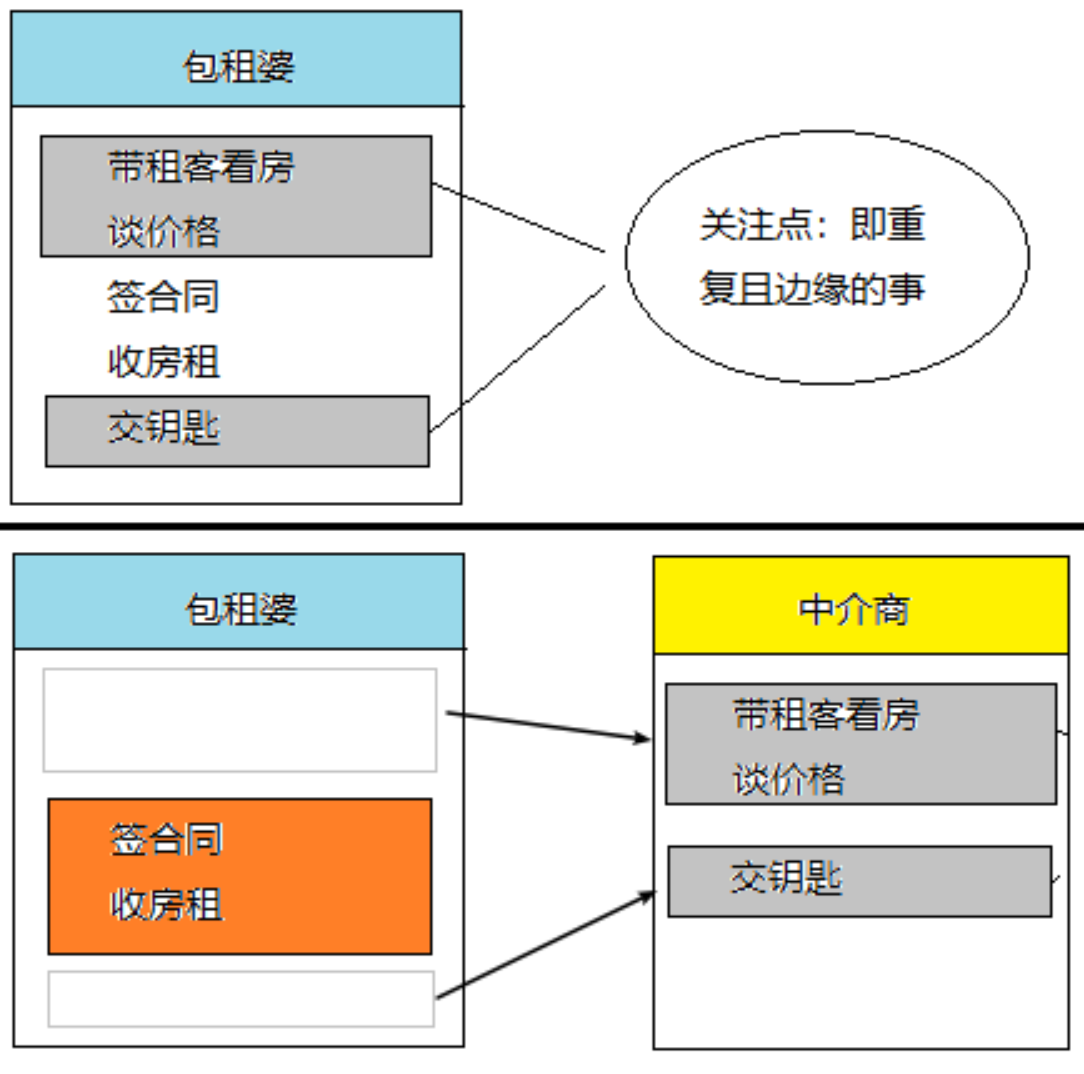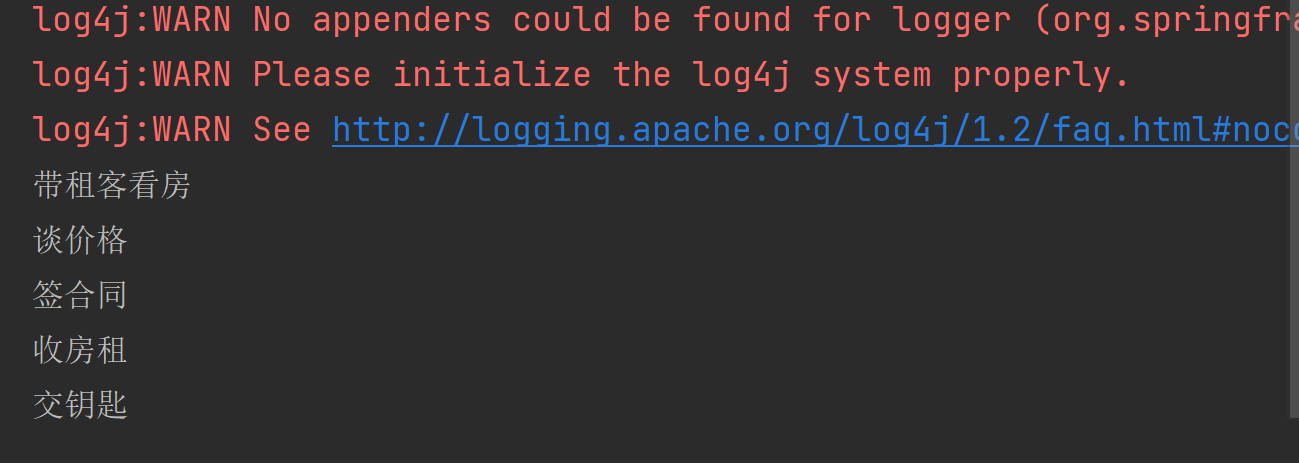Spring 学习笔记(5)AOP
本文介绍 Spring 中 AOP 的原理及使用方式。
Spring AOP 简介
如果说 IoC 是 Spring 的核心,那么面向切面编程就是 Spring 最为重要的功能之一了,在数据库事务中切面编程被广泛使用。
AOP 即 Aspect Oriented Program 面向切面编程
首先,在面向切面编程的思想里面,把功能分为核心业务功能,和周边功能。
- 所谓的核心业务,比如登陆,增加数据,删除数据都叫核心业务
- 所谓的周边功能,比如性能统计,日志,事务管理等等
周边功能在 Spring 的面向切面编程AOP思想里,即被定义为切面
在面向切面编程AOP的思想里面,核心业务功能和切面功能分别独立进行开发,然后把切面功能和核心业务功能 “编织” 在一起,这就叫AOP
AOP 的目的
AOP能够将那些与业务无关,却为业务模块所共同调用的逻辑或责任(例如事务处理、日志管理、权限控制等)封装起来,便于减少系统的重复代码,降低模块间的耦合度,并有利于未来的可拓展性和可维护性。
AOP 当中的概念:
- 切入点(Pointcut)
在哪些类,哪些方法上切入(where) - 通知(Advice)
在方法执行的什么实际(when:方法前/方法后/方法前后)做什么(what:增强的功能) - 切面(Aspect)
切面 = 切入点 + 通知,通俗点就是:在什么时机,什么地方,做什么增强! - 织入(Weaving)
把切面加入到对象,并创建出代理对象的过程。(由 Spring 来完成)
一个例子
为了更好的说明 AOP 的概念,我们来举一个实际中的例子来说明:

在上面的例子中,包租婆的核心业务就是签合同,收房租,那么这就够了,灰色框起来的部分都是重复且边缘的事,交给中介商就好了,这就是 AOP 的一个思想:让关注点代码与业务代码分离!
实际的代码
我们来实际的用代码感受一下
1.在 Package【com.riotian.pojo】下新建一个【Landlord】类(我百度翻译的包租婆的英文):
package com.riotian.pojo;
import org.springframework.stereotype.Component;
@Component("landlord")
public class Landload {
public void service() {
// 仅仅只是实现了核心的业务功能
System.out.println("签合同");
System.out.println("收房租");
}
}
2.在 Package【com.riotian.aspect】下新建一个中介商【Broker】类(我还是用的翻译…):
package com.riotian.aspect;
import org.aspectj.lang.annotation.After;
import org.aspectj.lang.annotation.Aspect;
import org.aspectj.lang.annotation.Before;
import org.springframework.stereotype.Component;
@Component
@Aspect
public class Broker {
@Before("execution(* com.riotian.pojo.Landload.service())")
public void before() {
System.out.println("带租客看房");
System.out.println("谈价格");
}
@After("execution(* com.riotian.pojo.Landload.service())")
public void after() {
System.out.println("交钥匙");
}
}
使用 @Aspect 之前需要导包
<dependency>
<groupId>org.aspectj</groupId>
<artifactId>aspectjweaver</artifactId>
<version>1.9.6</version>
</dependency>
<dependency>
<groupId>org.springframework</groupId>
<artifactId>spring-aop</artifactId>
<version>5.2.5.RELEASE</version>
</dependency>
3.在 applicationContext.xml 中配置自动注入,并告诉 Spring IoC 容器去哪里扫描这两个 Bean:
<?xml version="1.0" encoding="UTF-8"?>
<beans xmlns="http://www.springframework.org/schema/beans"
xmlns:xsi="http://www.w3.org/2001/XMLSchema-instance"
xmlns:context="http://www.springframework.org/schema/context"
xmlns:aop="http://www.springframework.org/schema/aop"
xsi:schemaLocation="http://www.springframework.org/schema/beans
http://www.springframework.org/schema/beans/spring-beans.xsd http://www.springframework.org/schema/context http://www.springframework.org/schema/context/spring-context.xsd http://www.springframework.org/schema/aop http://www.springframework.org/schema/aop/spring-aop.xsd">
<context:component-scan base-package="com.riotian.pojo"/>
<context:component-scan base-package="com.riotian.aspect"/>
<aop:aspectj-autoproxy/>
</beans>
4.在 Package【test】下编写测试代码:
@Test
public void TestAop() {
ApplicationContext app = new ClassPathXmlApplicationContext("applicationContext.xml");
Landload landlord = app.getBean("landlord", Landload.class);
landlord.service();
}
5.执行看到效果:

这个例子使用了一些注解,现在看不懂没有关系,但我们可以从上面可以看到,我们在 Landlord 的 service() 方法中仅仅实现了核心的业务代码,其余的关注点功能是根据我们设置的切面自动补全的。
使用注解来开发 Spring AOP
使用注解的方式已经逐渐成为了主流,所以我们利用上面的例子来说明如何用注解来开发 Spring AOP
第一步:选择连接点
Spring 是方法级别的 AOP 框架,我们主要也是以某个类额某个方法作为连接点,另一种说法就是:选择哪一个类的哪一方法用以增强功能。
....
public void service() {
// 仅仅只是实现了核心的业务功能
System.out.println("签合同");
System.out.println("收房租");
}
....
我们在这里就选择上述 Landlord 类中的 service() 方法作为连接点。
第二步:创建切面
选择好了连接点就可以创建切面了,我们可以把切面理解为一个拦截器,当程序运行到连接点的时候,被拦截下来,在开头加入了初始化的方法,在结尾也加入了销毁的方法而已,在 Spring 中只要使用 @Aspect 注解一个类,那么 Spring IoC 容器就会认为这是一个切面了:
package com.riotian.aspect;
import org.aspectj.lang.annotation.After;
import org.aspectj.lang.annotation.Aspect;
import org.aspectj.lang.annotation.Before;
import org.springframework.stereotype.Component;
@Component
@Aspect
public class Broker {
@Before("execution(* com.riotian.pojo.Landload.service())")
public void before() {
System.out.println("带租客看房");
System.out.println("谈价格");
}
@After("execution(* com.riotian.pojo.Landload.service())")
public void after() {
System.out.println("交钥匙");
}
}
- 注意: 被定义为切面的类仍然是一个 Bean ,需要
@Component注解标注
代码部分中在方法上面的注解看名字也能猜出个大概,下面来列举一下 Spring 中的 AspectJ 注解:
| 注解 | 说明 |
|---|---|
@Before |
前置通知,在连接点方法前调用 |
@Around |
环绕通知,它将覆盖原有方法,但是允许你通过反射调用原有方法,后面会讲 |
@After |
后置通知,在连接点方法后调用 |
@AfterReturning |
返回通知,在连接点方法执行并正常返回后调用,要求连接点方法在执行过程中没有发生异常 |
@AfterThrowing |
异常通知,当连接点方法异常时调用 |
有了上表,我们就知道 before() 方法是连接点方法调用前调用的方法,而 after() 方法则相反,这些注解中间使用了定义切点的正则式,也就是告诉 Spring AOP 需要拦截什么对象的什么方法,下面讲到。
第三步:定义切点
在上面的注解中定义了 execution 的正则表达式,Spring 通过这个正则表达式判断具体要拦截的是哪一个类的哪一个方法:
execution(* pojo.Landlord.service())
依次对这个表达式作出分析:
- execution:代表执行方法的时候会触发
*:代表任意返回类型的方法- pojo.Landlord:代表类的全限定名
- service():被拦截的方法名称
通过上面的表达式,Spring 就会知道应该拦截 pojo.Lnadlord 类下的 service() 方法。上面的演示类还好,如果多出都需要写这样的表达式难免会有些复杂,我们可以通过使用 @Pointcut 注解来定义一个切点来避免这样的麻烦:
package com.riotian.aspect;
import org.aspectj.lang.annotation.After;
import org.aspectj.lang.annotation.Aspect;
import org.aspectj.lang.annotation.Before;
import org.aspectj.lang.annotation.Pointcut;
import org.springframework.stereotype.Component;
@Component
@Aspect
public class Broker {
@Pointcut("execution(* com.riotian.pojo.Landload.service())")
public void lService() {
}
@Before("lService()")
public void before() {
System.out.println("带租客看房");
System.out.println("谈价格");
}
@After("lService()")
public void after() {
System.out.println("交钥匙");
}
}
第四步:测试 AOP
编写测试代码,但是我这里因为 JDK 版本不兼容出现了 BUG….(尴尬…)
这就告诉我们:环境配置很重要…不然莫名其妙的 BUG 让你崩溃…
环绕通知
我们来探讨一下环绕通知,这是 Spring AOP 中最强大的通知,因为它集成了前置通知和后置通知,它保留了连接点原有的方法的功能,所以它及强大又灵活,让我们来看看:
package com.riotian.aspect;
import org.aspectj.lang.ProceedingJoinPoint;
import org.aspectj.lang.annotation.*;
import org.springframework.stereotype.Component;
//@Component
//@Aspect
public class Broker {
// 注释掉之前的 @Before 和 @After 注解以及对应的方法
// @Before("execution(* com.riotian.pojo.Landload.service())")
// public void before() {
// System.out.println("带租客看房");
// System.out.println("谈价格");
// }
//
// @After("execution(* com.riotian.pojo.Landload.service())")
// public void after() {
// System.out.println("交钥匙");
// }
// 使用 @Around 注解来同时完成前置和后置通知
//@Around("execution(* com.riotian.pojo.Landload.service())")
public void around(ProceedingJoinPoint joinPoint) {
System.out.println("带租客看房");
System.out.println("谈价格");
try {
joinPoint.proceed();
} catch (Throwable throwable) {
throwable.printStackTrace();
}
System.out.println("交钥匙");
}
}
运行测试代码,结果仍然正确:

使用 XML 配置开发 Spring AOP
注解是很强大的东西,但基于 XML 的开发我们仍然需要了解,我们先来了解一下 AOP 中可以配置的元素:
| AOP 配置元素 | 用途 | 备注 |
|---|---|---|
aop:advisor |
定义 AOP 的通知其 | 一种很古老的方式,很少使用 |
aop:aspect |
定义一个切面 | —— |
aop:before |
定义前置通知 | —— |
aop:after |
定义后置通知 | —— |
aop:around |
定义环绕通知 | —— |
aop:after-returning |
定义返回通知 | —— |
aop:after-throwing |
定义异常通知 | —— |
aop:config |
顶层的 AOP 配置元素 | AOP 的配置是以它为开始的 |
aop:declare-parents |
给通知引入新的额外接口,增强功能 | —— |
aop:pointcut |
定义切点 | —— |
有了之前通过注解来编写的经验,并且有了上面的表,我们将上面的例子改写成 XML 配置很容易(去掉所有的注解):
<!-- 装配 Bean-->
<bean name="landlord" class="com.riotian.pojo.Landload"/>
<bean id="broker" class="com.riotian.aspect.Broker"/>
<!-- 配置AOP -->
<aop:config>
<!-- where:在哪些地方(包.类.方法)做增加 -->
<aop:pointcut id="landlorddPoint" expression="execution(* com.riotian.pojo.Landload.service())"/>
<!-- what:做什么增强 -->
<aop:aspect id="logAspect" ref="broker">
<!-- when:在什么时机(方法前/后/前后) -->
<aop:around method="around" pointcut-ref="landlorddPoint"/>
</aop:aspect>
</aop:config>
运行测试程序,看到正确结果:

扩展阅读:Spring【AOP模块】就这么简单 、 关于 Spring AOP(AspectJ)你该知晓的一切(慎独读,有些深度…)
参考资料:
- 《Java EE 互联网轻量级框架整合开发》
- 《Java 实战(第四版)》
- 万能的百度 and 万能的大脑
Spring 学习笔记(5)AOP的更多相关文章
- Spring学习笔记之aop动态代理(3)
Spring学习笔记之aop动态代理(3) 1.0 静态代理模式的缺点: 1.在该系统中有多少的dao就的写多少的proxy,麻烦 2.如果目标接口有方法的改动,则proxy也需要改动. Person ...
- Spring学习笔记4——AOP
AOP 即 Aspect Oriented Program 面向切面编程 首先,在面向切面编程的思想里面,把功能分为核心业务功能,和周边功能. 所谓的核心业务,比如登陆,增加数据,删除数据都叫核心业务 ...
- [Spring学习笔记 4 ] AOP 概念原理以及java动态代理
一.Spring IoC容器补充(1) Spring IoC容器,DI(依赖注入): 注入的方式:设值方法注入setter(属性注入)/构造子注入(构造函数传入依赖的对象)/字段注入Field(注解) ...
- Spring学习笔记2—AOP
1.AOP概念 AOP(Aspect Oriented Programming):面向切面编程,AOP能够将那些与业务无关,却为业务模块所共同调用的应用(例如事务处理.日志管理.权限控制等)封装起来, ...
- Spring学习笔记之AOP配置篇(一)
[TOC] 1. 创建并声明一个切面 首先,创建一个类,添加@Component注解使其添加到IoC容器 然后,添加@Aspect注解,使其成为一个切面 最后,在配置文件里面,使用<aop:as ...
- Spring学习笔记 - 第三章 - AOP与Spring事务
原文地址:Spring学习笔记 - 第三章 - AOP与Spring事务 Spring 学习笔记全系列传送门: Spring学习笔记 - 第一章 - IoC(控制反转).IoC容器.Bean的实例化与 ...
- spring学习笔记(一) Spring概述
博主Spring学习笔记整理大部分内容来自Spring实战(第四版)这本书. 强烈建议新手购入或者需要电子书的留言. 在学习Spring之前,我们要了解这么几个问题:什么是Spring?Spring ...
- Java框架spring 学习笔记(十八):事务管理(xml配置文件管理)
在Java框架spring 学习笔记(十八):事务操作中,有一个问题: package cn.service; import cn.dao.OrderDao; public class OrderSe ...
- 不错的Spring学习笔记(转)
Spring学习笔记(1)----简单的实例 --------------------------------- 首先需要准备Spring包,可从官方网站上下载. 下载解压后,必须的两个包是s ...
- 【Spring学习笔记-MVC-5】利用spring MVC框架,实现ajax异步请求以及json数据的返回
作者:ssslinppp 时间:2015年5月26日 15:32:51 1. 摘要 本文讲解如何利用spring MVC框架,实现ajax异步请求以及json数据的返回. Spring MV ...
随机推荐
- vue 组件之间的自定义方法互相调用
1,先定义一个中间通信文件js globalBus.js import Vue from 'vue'; export const globalBus = new Vue(); 2,A.vue组件的方法 ...
- [NewStarCTF WEEK5] pwn-planet 详解
这道题目更多是考pwner的逆向功底(虽然程序逻辑也不是非常复杂=_=) 老规矩,先checksec查看程序 保护全开 看一下main函数 __int64 __fastcall main(int a1 ...
- .NET8极致性能优化AOT
前言 .NET8对于性能的优化是方方面面的,所以AOT预编译机器码也是不例外的.本篇来看下对于AOT的优化.原文:.NET8极致性能优化AOT 详述 首先明确一个概念,.NET里面的AOT它是原生的. ...
- 后端程序员必会的前端知识-04:Vue3
Vue 3 1. TypeScript 1) 动态类型的问题 前面我们讲过 js 属于动态类型语言,例如 function test(obj) { } obj 可能只是个字符串 test('hello ...
- 深入 K8s 网络原理(二)- Service iptables 模式分析
目录 1. 概述 2. 准备 Service 和 Pods 资源 3. K8s 里 Service 的实现原理 3.1 kube-proxy 组件 3.2 iptables 简介 3.3 iptabl ...
- 华企盾DSC防泄密软件造成VS启动报目录错误
解决方法:找到安装路径下的Privateregistry.bin文件解密即可
- libgdx摄像头的移动
要知道,做一个游戏,摄像头是必不可少的.接下来,我将讲解libgdx里面摄像头的移动 2d摄像头OrthographicCamera也叫做正交相机 结果展示: 按上下左右是可以移动的 Orthogra ...
- 解决方案 | VS2022 + AutoCAD2024 + ObjectARX2024环境搭建过程
一.准备工具 1.vs2022 自行网络搜索,各种版本均可(比如专业版.社区版),注意使用社区版必须使用最新版,目前是17.8版本,否则最终会无法使用样板. 2.cad2024 自行网络搜索 3.Ob ...
- DC-3
DC-3 前言:这个DC系列去年就做完了,但是因为那时候visualbox老崩搞得头大,一直漏了DC-3没做.现在重新搞好了来完结这个系列 扫存活的主机,显示只开了80 扫了一下目录,看了几个没有什么 ...
- const 方法可以改变(智能)指针成员指向的对象
<C++ Primer 5th> P406 const 方法,不能修改指针本身,但是可以修改指针指向的对象! class Foo { public: Foo() : c(new int() ...
